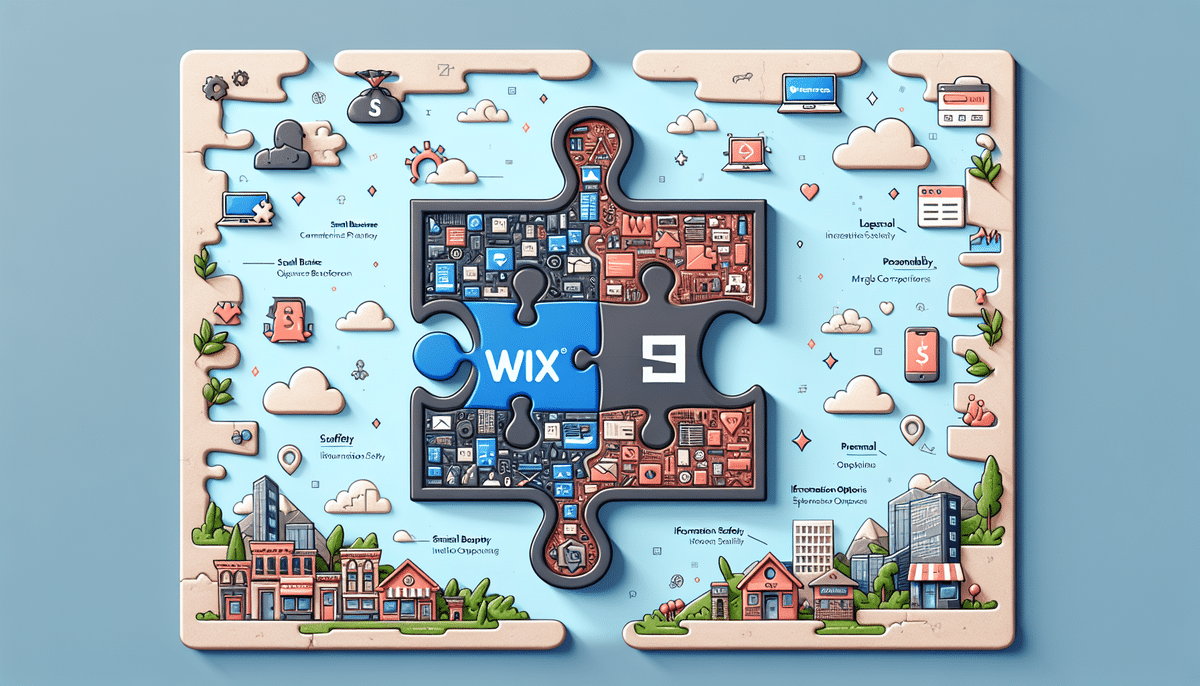Amazon vs Square Online: A Comprehensive Comparison
In today's digital age, establishing a strong online presence is essential for business success. Entrepreneurs and businesses face a pivotal decision when choosing between e-commerce platforms like Amazon and Square Online. This article delves into an in-depth comparison of Amazon and Square Online, examining their features, pricing, user interfaces, payment and shipping options, marketing tools, customer service, security measures, and real-world case studies. By the end, you'll be equipped with the knowledge to determine which platform aligns best with your online business objectives.
Overview of Amazon and Square Online
Amazon
Founded in 1994 by Jeff Bezos, Amazon has evolved from an online bookstore into the world's largest e-commerce retailer, operating in over 180 countries with a customer base exceeding 300 million worldwide. Amazon's expansive product range includes electronics, clothing, groceries, and more, supported by services like Amazon Prime, which offers benefits such as free two-day shipping and access to streaming platforms like Amazon Prime Video. Additionally, Amazon boasts a robust third-party seller marketplace, enabling businesses of all sizes to reach a vast audience.
Square Online
Square, established in 2009 by Jack Dorsey, initially focused on mobile payment solutions before expanding into comprehensive tools for small businesses, including Square Online. Launched in 2019, Square Online provides customizable website templates, inventory management, and seamless integration with Square's Point of Sale (POS) system, facilitating an omnichannel selling experience. This platform is designed to empower small businesses to effortlessly transition from physical to online sales.
Key Features Comparison
Amazon's Features
- Amazon Prime: Offers free two-day shipping, streaming services, and exclusive deals.
- Advertising Platform: Enables businesses to create sponsored product listings to enhance visibility.
- Fulfillment by Amazon (FBA): Allows sellers to store products in Amazon's warehouses, with Amazon handling fulfillment and shipping.
- Amazon Web Services (AWS): Provides scalable cloud computing solutions for businesses.
Square Online's Features
- Customizable Templates: Allows businesses to design their website to reflect their brand identity.
- Inventory Management: Tools to track stock levels and manage product listings efficiently.
- Payment Processing: Secure and versatile payment options, including credit/debit cards, Apple Pay, and Google Pay.
- Integration with Square POS: Seamless synchronization of online and in-store sales data.
- Gift Cards and Custom Checkout: Features to promote sales and enhance customer experience.
Pricing and Cost Analysis
Amazon's Pricing Structure
Amazon employs a multifaceted fee system for sellers, which includes:
- Individual Selling Plan: $0.99 per item sold.
- Professional Selling Plan: $39.99 monthly subscription, plus referral fees that vary by product category.
- Additional Fees: Charges for FBA, advertising, and other optional services.
According to Statista, Amazon's marketplace generated approximately $470 billion in revenue in 2021, underscoring its expansive reach and cost implications for sellers.
Square Online's Pricing Structure
Square Online offers a more transparent pricing model with:
- Free Plan: Basic e-commerce features, including online product listings and website creation.
- Paid Plans: Ranging from $12 to $72 per month, offering advanced features like selling on social media platforms and enhanced customization options.
- Transaction Fees: Flat-rate processing fees with no additional charges for using the platform.
This straightforward pricing approach makes Square Online particularly attractive to small businesses and startups aiming to minimize overhead costs.
User Experience and Interface
Amazon's User Interface
Amazon's platform is comprehensive but can be overwhelming for new sellers due to its extensive range of features and tools. However, Amazon provides detailed documentation, tutorials, and support resources to assist businesses in navigating the platform effectively.
Square Online's User Interface
Square Online is renowned for its intuitive and user-friendly interface. The platform simplifies the setup process, allowing businesses to launch their online store without technical expertise. Customization is straightforward, and the integration with Square's POS system ensures a cohesive user experience across all sales channels.
Payment and Shipping Options
Payment Options
- Amazon:
- Accepts major credit and debit cards.
- Amazon Pay: Enables customers to use their Amazon accounts for streamlined purchases.
- Lending Program: Offers eligible sellers business loans to support growth.
- Square Online:
- Accepts credit and debit cards, Apple Pay, and Google Pay.
- Integrates with Square's POS hardware for seamless in-store and online transactions.
- Square Loans: Provides financing options for eligible businesses.
Shipping Options
- Amazon:
- Fulfillment by Amazon (FBA): Handles storage, packing, and shipping.
- Various shipping speeds, including one-day and two-day options for Prime members.
- Square Online:
- Offers shipping through USPS, UPS, and FedEx.
- Businesses can set custom shipping rates or offer free shipping promotions.
- Order management and fulfillment are handled through Square's POS software.
Marketing Tools and Customer Support
Marketing Tools
- Amazon:
- Amazon Advertising: Sponsored product listings and display ads to boost visibility.
- Promotions like lightning deals and coupons to drive sales.
- Square Online:
- Integrated Facebook and Instagram advertising tools.
- Options to create gift cards and loyalty programs to enhance customer retention.
Customer Support
- Amazon:
- Comprehensive support resources, including a help center and community forums.
- Dedicated phone and email support for sellers.
- Square Online:
- Extensive help center with articles and tutorials.
- Responsive phone and email support.
- Support available through social media channels.
Security Measures
- Amazon: Invests significantly in cybersecurity infrastructure to protect against hacking, fraud, and data breaches. Utilizes advanced encryption and monitoring systems to ensure data integrity and security.
- Square Online: Implements SSL encryption, PCI compliance, and robust security protocols to safeguard customer and business data. Square's hardware is designed to prevent unauthorized access and fraudulent activities.
Case Studies of Successful Businesses
Numerous businesses have thrived by leveraging both Amazon and Square Online platforms. Here are a few examples:
- Handmade Soap Business: Utilizing Amazon's vast customer base and search algorithms, this business saw a significant increase in sales by listing unique handmade products on Amazon's marketplace.
- Local Coffee Shop: By integrating Square Online with its existing Square POS system, the coffee shop efficiently managed both online orders and in-person sales, enhancing customer convenience and operational efficiency.
- Tech Gadget Retailer: Employed Amazon's FBA services to handle logistics and shipping, allowing the retailer to focus on product development and marketing, resulting in a scalable business model.
Choosing the Right Platform for Your Business
Deciding between Amazon and Square Online depends on various factors related to your business's unique needs and goals. Consider the following when making your choice:
- Audience Reach: If your primary goal is to tap into a massive, global customer base, Amazon is unparalleled. However, this comes with higher fees and intense competition.
- Budget Constraints: For businesses operating on a tighter budget, Square Online offers more affordable pricing with transparent fees.
- Control Over Branding: Square Online provides greater flexibility in customizing your online store, allowing for a more personalized brand experience.
- Integration Needs: If seamless integration with in-store sales is crucial, Square Online's synergy with Square's POS system is advantageous.
- Product Type: Niche and handmade products may perform better on Amazon due to its extensive search capabilities, while unique local offerings might thrive on Square Online.
Conclusion: Which Platform Suits Your Online Business?
Both Amazon and Square Online offer robust features and tools to facilitate online selling, but they cater to different business needs. Amazon excels in providing access to a vast customer base and comprehensive fulfillment services, making it ideal for businesses aiming for scalability and broad market reach. On the other hand, Square Online shines with its user-friendly interface, transparent pricing, and seamless integration with in-store sales, making it a perfect choice for small to medium-sized businesses seeking control over their branding and operational efficiency.
Ultimately, the choice between Amazon and Square Online should align with your business objectives, budget, and the level of control you desire over your online presence. Assess your priorities, consider the factors outlined in this comparison, and select the platform that best enhances your online selling strategy.




















